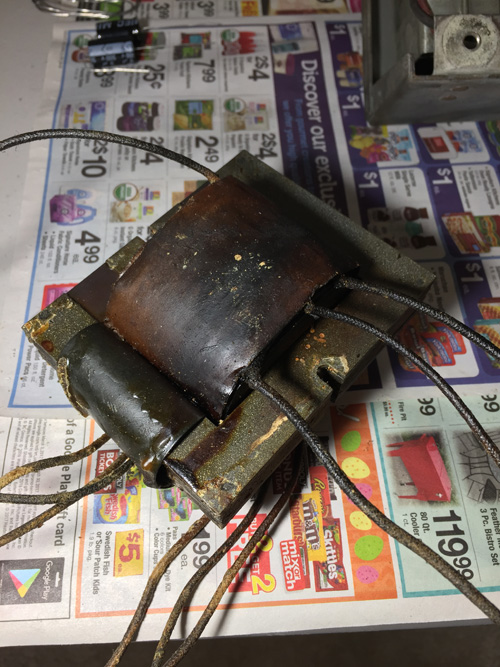Posts: 28
Threads: 7
Joined: Feb 2017
City: Coatesville PA
Starting to work on my Philco 89 and I just removed the pwr trans. There is a LOT of wax under the trans so I'm guessing it got pretty hot at some point. I hooked it up to my variac and surprisingly no smoke and all the voltages are within spec. Plus resistance measurements from the frame to all of the windings reads infinite. My question is whether all the wax loss will affect the insulation resistance or cause some other problems down the road.

***********
Dave Thomas
Coatesville, PA
Posts: 16,533
Threads: 573
Joined: Oct 2011
City: Jackson
State, Province, Country: NJ
Wax could be lost due to some bad components overloading the transformer, which might not necessarily be the case if all is recapped/retubed.
The transformer might still be OK.
The fact that the was escaped may or may not affect the function; the only way to find out is to test it. You could use a megaohmmeter to check for the leakage between the windings and the case, and plain voltage measurement and then loading for checking how it handles the load.
People who do not drink, do not smoke, do not eat red meat will one day feel really stupid lying there and dying from nothing.
Posts: 44
Threads: 4
Joined: Dec 2013
City: Freeport, LI, NY
Could be that the voltage divider was throwing heat and between the normal transformer heat could've caused the oozing.
Does the transformer "smell" when operating?
...Jim
Good luck with the project and all of us here are expecting a full report when you're finished.
Posts: 28
Threads: 7
Joined: Feb 2017
City: Coatesville PA
I pulled apart the transformer and it looks like it got really hot at some point and has a burnt smell when you sniff close to the paper insulation. I found a used one, same part number, that looks much better with no charred spots or dripping wax. I repaired the wiring and with no load all of the windings read the correct voltages. But I did notice that after about 100 vac on the variac the primary ac current starts to bump up a bit and settles at about 160 ma. With no load I thought that I wouldn't see much if any current draw from the trans. Does anyone know if this is normal or maybe an indication of shorted turns? Like I said, all of the voltages are right on target and I'm not measuring any leakage from the windings to the frame.

***********
Dave Thomas
Coatesville, PA
Posts: 1,114
Threads: 14
Joined: Feb 2013
City: Irvington, NY
Leave it on for a while with full line voltage applied and see if it gets warm. I don't know the normal unloaded current draw but some is normal.
The transformer is an inductor, and as such it will draw some magnetizing current. Since with an inductor the current is not in phase with the applied AC voltage, it is reactive current and not indicative of any "real" power being dissipated. The transformer should therefor not get very warm with no load. If it does, then real power is being dissipated and it has a problem.
Posts: 16,533
Threads: 573
Joined: Oct 2011
City: Jackson
State, Province, Country: NJ
Yep, looks a bit blackened, like the catfish in our diner.
Do what Mondial says.
I would start with a Variac so not to pull lots of smoke in case it is in a damaged condition.
People who do not drink, do not smoke, do not eat red meat will one day feel really stupid lying there and dying from nothing.
Posts: 1,114
Threads: 14
Joined: Feb 2013
City: Irvington, NY
Since you have another identical power transformer, why not measure its current draw and see how it compares to the toasted one. If they are the same, it doesn't get warm and the voltages are all in spec its probably OK.
The melted transformer probably had an external short in the radio like a bad filter cap or rectifier which caused it to overheat.
Posts: 28
Threads: 7
Joined: Feb 2017
City: Coatesville PA
They both draw some current with no load. The toasted one actually draws less than the better looking one, about 100 ma vs 160 ma so I'm guessing that either a small amount is normal or both have issues. I'll leave the nicer looking one run for a while to see if it heats up. Anybody have a known good power transformer to see if some primary current draw unloaded at 120 vac is normal?
***********
Dave Thomas
Coatesville, PA




![[-] [-]](https://philcoradio.com/phorum/images/bootbb/collapse.png)


